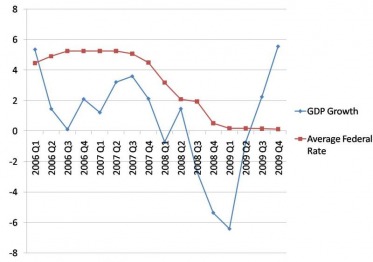Monetary Policy and the Economy

The monetary policy of the Greenspan era in the Aughts was marked by a period of low interest rates in order to allow the economy to recover from the bursting of the Dot Com Bubble. These low rates promoted excessive lending that may have contributed to the housing bubble, which ultimately ended in disaster and led to the financial crisis and the ongoing recession. The monetary policy response to the current recession has been similar in some regards to Greenspan's response to the recession of 2001; both of these responses were the result of an economic bubble, and some believe that the current response could lead to the formation of yet another.
There have been numerous accusations that the monetary policies of the early 2000s created an environment conducive to inexpensive and excessive lending and the formation of the Housing Bubble, which ultimately led to the Great Recession. Indeed, the Federal Reserve came under heavy criticism and scrutiny from politicians and citizens alike during the financial crisis as a result. Therefore, the Federal Reserve is making a concerted effort to orchestrate its current and future policy in a way that would preclude another economic bubble/crisis from forming while still allowing for a sustained recovery. This task is an especially onerous one because if policy is tightened too quickly, the recovery could lapse and retrogress; however, if policy remains too accommodative for too long high inflation could flare up, which would damage economic growth.
There have been numerous accusations that the monetary policies of the early 2000s created an environment conducive to inexpensive and excessive lending and the formation of the Housing Bubble, which ultimately led to the Great Recession. Indeed, the Federal Reserve came under heavy criticism and scrutiny from politicians and citizens alike during the financial crisis as a result. Therefore, the Federal Reserve is making a concerted effort to orchestrate its current and future policy in a way that would preclude another economic bubble/crisis from forming while still allowing for a sustained recovery. This task is an especially onerous one because if policy is tightened too quickly, the recovery could lapse and retrogress; however, if policy remains too accommodative for too long high inflation could flare up, which would damage economic growth.
